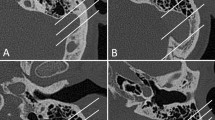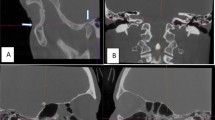Abstract
Eustachian tube dysfunction is believed to be an important factor to cholesteatoma development and recurrence of disease after surgical treatment. Although many studies have described prognostic factors, evaluation methods, or surgical techniques for Eustachian tube dysfunction, they relied on the soft tissues of its structure; little is known about its bony structure—the protympanum—which connects the Eustachian tube to the tympanic cavity, and can also be affected by several inflammatory conditions, both from the middle ear or from the nasopharynx. We studied temporal bones from patients with cholesteatoma, chronic otitis media (with and without retraction pockets), purulent otitis media, and non-diseased ears, looking for differences between the volume of the protympanum, the diameter of the Eustachian tube isthmus, and the distance between the anterior tympanic annulus and the promontory. Light microscopy and 3-D reconstruction software were used for the measurements. We observed a decrease of volume in the lumen of the four middle ear diseased ears compared to the control group. We observed a significant decrease in the volume of the protympanic space in the cholesteatoma group compared to the chronic otitis media group. We also observed a decrease in the bony space (protympanum space) in cholesteatoma, chronic otitis media with retraction pockets, and purulent otitis media compared to the control group. We found a correlation in middle ear diseases and a decrease in the middle ear space. Our findings may suggest that a smaller bony volume in the protympanic area may trigger middle ear dysventilation problems.


Similar content being viewed by others
References
Lee D-H, Jung M-K, Yoo Y-H, Seo J-H (2008) Analysis of unilateral sclerotic temporal bone: how does the sclerosis change the mastoid pneumatization morphologically in the temporal bone? Surg Radiol Anat 30:221–227
Louw L (2010) Acquired cholesteatoma pathogenesis: stepwise explanations. J Laryngol Otol 124:587–593
Poe DS, Silvola J, Pyykkö I (2011) Balloon dilation of the cartilaginous eustachian tube. Otolaryngol Head Neck Surg 144(4):563–569
Donaldson JA, Duckert LG (1991) Anatomy of the ear. In: Paparella MM, Shumrick DA (eds) Otolaryngology. W.B. Saunders Company, Philadelphia, pp 23–58
Tóth M, Medvegy T, Moser G, Patonay L (2006) Development of the protympanum. Ann Anat 188:267–273
Habesoglu TE, Habesoglu M, Toros SZ, Deveci I, Surmeli M, Sheidaei S, Baran A, Egeli E (2010) How does childhood otitis media change the radiological findings of the temporal bone? Acta Oto-Laryngol 130(11):1225–1229
Tarabichi M, Najmi M (2015) Visualization of the Eustachian tube lumen with Valsalva computed tomography. Laryngoscope 125:724–729
Linstrom CJ, Silverman CA, Rosen A, Meiteles LZ (2000) Eustachian tube endoscopy in patients with chronic ear disease. Laryngoscope 110:1884–1889
Albera R, Nadalin J, Garzaro M, Lacilla M, Pecorari G, Canale A (2008) Condition of the anterior part of the middle ear cleft in acquired cholesteatoma. Acta Oto-Laryngologica 128(6):634–638
Marchioni D, Mattioli F, Alicandri-Ciufelli M, Presutti L (2009) Endoscopic approach to tensor fold in patients with attic cholesteatoma. Acta Oto-Laryngol 129:946–954
Issacson G (2014) Endoscopic anatomy of the pediatric middle ear. Otolaryngol Head Neck Surg 150:6–15
Sudo M, Sando I, Ikui A, Suzuki C (1997) Narrowest (isthmus) portion of the eustachian tube: a computer-aided three-dimensional reconstruction and measurement study. Ann Otol Rhinol Laryngol 106:583–588
Jen A, Sanelli PC, Banthia V, Victor JD, Selesnick SH (2004) Relationship of petrous temporal bone pneumatization to the Eustachian tube lumen. Laryngoscope 114:656–660
Tarabichi M, Najmi M (2015) Site of Eustachian tube obstruction in chronic ear disease. Laryngoscope 125:2572–2575
Sadé J, Berco E (1976) Atelectasis and secretory otitis media. Ann Otol Rhinol Laryngol 85:66–72
Williams GH (1993) Developmental anatomy of the ear. In: English GM (ed) Otolaryngology. J. B. Lippincott Company, Philadelphia, pp 1–67
Sadé J, Luntz M (1989) Eustachian tube lumen: comparison between normal and inflamed specimens. Ann Otol Rhinol Laryngol 98(8 Pt 1):630–634
Conticello S, Saita V, Ferlito S, Paterno A (1989) Computed tomography in the study of the eustachian tube. Arch Otorhinolaryngol 246(5):259–261
Bluestone CD (1983) Eustachian tube function: physiology, pathophysiology, and role of allergy in pathogenesis of otitis media. J Allergy Clin Immunol 72:242–251
Yoon TH, Schachern PA, Paparella MM, Aeppli DM (1990) Pathology and pathogenesis of tympanic membrane retraction. Am J Otolaryngol 11:10–17
Adil E, Poe D (2014) What is the full range of medical and surgical treatments available for patients with Eustachian tube dysfunction? Curr Opin Otolaryngol Head Neck Surg 22:8–15
Paparella MM, Schachern PA, Yoon TH, Abdelhammid MM, Sahni R, da Costa SS (1990) Otopathologic correlates of the continuum of otitis media. Ann Otol Rhinol Laryngol Suppl. 148:17–22
Jufas N, Marchioni D, Tarabichi M, Patel N (2016) Endoscopic anatomy of the protympanum. Otolaryngol Clin North Am. 49:1107–1119
Ars B, Dirckx J (2016) Eustachian tube function. Otolaryngol Clin North Am 49:1121–1133
Piiper J (1965) Physiological equilibria of gas cavities in the body. In: Fenn W, Rahn H (eds) Handbook of physiology, section 3: respiration. American Physiological Society, Washington, DC, pp 1205–1218
Marchioni D, Alicandri-Ciufelli M, Molteni G, Artioli FL, Genovese E, Presutti L (2010) Selective epitympanic dysventilation syndrome. Laryngoscope 120:1028–1033
Monsanto RC, Pauna HF, Kwon G, Schachern PA, Tsuprun V, Paparella MM, Cureoglu S (2016) A three-dimensional analysis of the endolymph drainage system in Ménière disease. The Laryngoscope. doi:10.1002/lary.26155
Shirai K, Schachern PA, Schachern MG, Paparella MM, Cureoglu S (2015) Volume of the epitympanum and blockage of the tympanic isthmus in chronic otitis media: a human temporal bone study. Otol Neurotol 36:254–259
Acknowledgements
This project was funded by NIH NIDCD U24 DC011968, International Hearing Foundation, Starkey Hearing Foundation, and Lions 5 M International.
Author information
Authors and Affiliations
Corresponding author
Ethics declarations
Funding
This study was funded by NIH NIDCD U24 DC011968, International Hearing Foundation, Starkey Hearing Foundation, and Lions 5 M International.
Conflict of interest
None.
Research involving human participants and/or animals
This article does not contain any studies with human participants performed by any of the authors. The Institutional Review Board of the University of Minnesota approved this study (0206M26181).
Informed consent
Not applicable.
Rights and permissions
About this article
Cite this article
Pauna, H.F., Monsanto, R.C., Schachern, P. et al. A 3-D analysis of the protympanum in human temporal bones with chronic ear disease. Eur Arch Otorhinolaryngol 274, 1357–1364 (2017). https://doi.org/10.1007/s00405-016-4396-4
Received:
Accepted:
Published:
Issue Date:
DOI: https://doi.org/10.1007/s00405-016-4396-4




